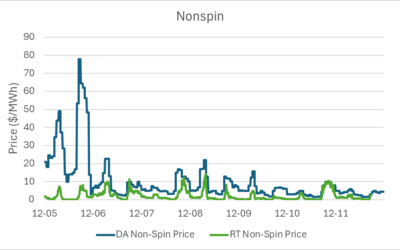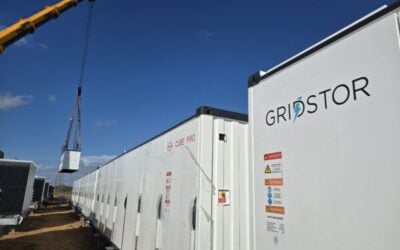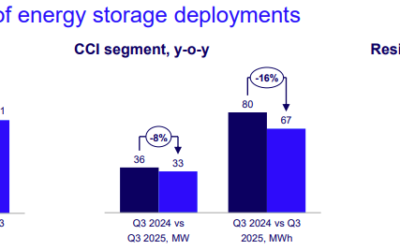Younicos recently launched an energy consultancy in the US and is preparing its first “major” report, Hiersemenzel said. Image: Younicos.
Reports that a grid operator in France has found battery-based energy storage “too costly” to be used to integrate renewable energy have been criticised by a spokesman for energy storage developer Younicos.
At the beginning of this month, Reuters reported that a multi-million Euro pilot in the southern French region of Nice had shown “battery storage of renewable energy is not yet economically viable in Europe”, with Reuters journalist Geert De Clercq calling the conclusion a “sobering one for proponents of sun and wind energy”.
De Clercq reported comments from Philip Monloubou, chief of ERDF, a subsidiary of utility EDF tasked with overseeing grid infrastructure, in a story published on 5 July.
“The economic model of the batteries is not mature yet,” Monloubou was quoted as saying.
Try Premium for just $1
- Full premium access for the first month at only $1
- Converts to an annual rate after 30 days unless cancelled
- Cancel anytime during the trial period
Premium Benefits
- Expert industry analysis and interviews
- Digital access to PV Tech Power journal
- Exclusive event discounts
Or get the full Premium subscription right away
Or continue reading this article for free
The pilot is part of the wider European Union GRID4EU programme which includes major utilities in a number of other regions, including Italy, Spain and the Czech Republic trialling new ways to use a number of different grid-related technologies and applications, such as demand response and combined heat and power (CHP) generation.
Stacking benefits
Younicos spokesman Philip Hiersemenzel was scathing in his rebuttal of the conclusions the Reuters piece appeared to support. He said that, with the exception of self-consumption markets, such as that which exists for residential PV in Germany (which the Reuters piece did allude to), using energy storage simply to store energy is “no business case”.
“If you use storage wrong, there is no business case,” Hiersemenzel told PV Tech Storage yesterday.
Engineer Melissa Lott has previously spoken to PV Tech Storage about building business cases around “benefits stacking”, which she said could help storage overcome some “crippling challenges”. In other words, using energy storage not just to smooth out variable renewable energy sources, or to shift the load from solar or wind for later use, but allowing energy storage to simultaneously also play into grid-balancing ancillary services markets, for example.
In response to the Reuters report, Lott, who has also written for PV Tech Storage’s Guest Blog in the past, explained the case for benefit stacking further.
“In order to support the widespread deployment of energy storage technologies, we need to create an environment where storage can be compensated for the multiple services that it can provide. Battery storage can be used for much more than just storing solar energy during the day and discharging it at night. By allowing these systems to supply a range of energy and power services – and compensating them for it – the cost-benefits balance will be greatly improved.”
Lott also said that she sees storage as one among a number of flexibility options that can be used to benefit the grid, with demand-side response and even natural gas plants viable near-term options.
“Energy storage is a valuable tool that we can use to support the integration of intermittent renewables like wind and solar. But, it is not our only option,” Lott said.
“
In order to support the widespread deployment of energy storage technologies, we need to create an environment where storage can be compensated for the multiple services that it can provide.”
Evolving the business models
Indeed, the better-informed among ‘proponents of sun and wind energy’ may not find the assessment from ERDF on the Nice Grid programme much of a surprise. Solar industry veteran Jigar Shah recently made headlines with comments given to the effect that using storage purely for the integration of renewables is not likely to be a ‘silver bullet’ that can make batteries profitable. Matt Roberts, executive director of the Energy Storage Association, at whose conference Shah made those comments, backed up Shah in a recent interview for PV Tech Storage.
“…renewable integration isn’t the ‘killer app’, it isn’t the high value application that’s going to revolutionise the storage industry, but it’s among the drivers for continued storage adoption. Storage really shines when we’re talking about resiliency and grid infrastructure challenges and choke points and congestion on the system and once again just back to the flexibility issue,” Roberts said.
One prominent example of how business models for storage are still evolving is a recently announced Younicos project in Texas. The German-American company will upgrade existing 36MW storage facilities at the Notrees wind farm for utility Duke Energy, in partnership with battery provider Samsung SDI. Lead acid batteries which had previously been installed by the original project developer, Xtreme Power – which Younicos acquired last year – are to be replaced with lithium-ion ones.
“Duke were using this facility more for primary frequency response rather than ramping and peak shaving which they originally thought they would do,” Hiersemenzel said. “That basically really puts a different strain on the battery.”
“What happened really was that the frequency response market became more interesting from a monetary point of view because the speed and accuracy [battery storage can provide relative to traditional gas peaker plants] are increasingly being rewarded in the US.”
Hiersemenzel says Younicos’ recently established consultancy arm is preparing a report on how storage can be used to shore up N-1 security of a grid and reduce the ‘payback time’ of batteries. N-1 (‘N minus one’) is used to ensure that in the event of any component of an electrical system failing, even the biggest, the ‘must run’ capacity requirements of the system can still be met without the entire system failing. At this stage in preparing the report, however, Hiersemenzel said he was not to able to divulge further details.
This article has been amended to correct an incorrect reference to the US Energy Storage Association as the Electricity Storage Association.





